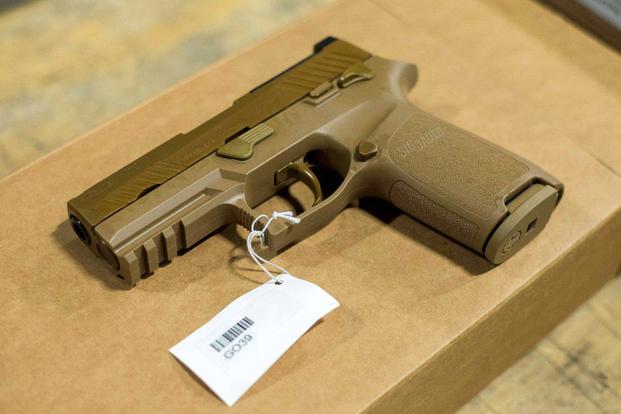The U.S. Army got a good deal on its new Modular Handgun System, according to a recent report from the Congressional Research Service, but the official pricing numbers remain murky.
The public policy research arm of Congress published a June 19 analysis of the "Army's Modular Handgun Procurement."
The CRS summarizes the bureaucratic challenges the program faced and compares the projected costs to the Army's deal with Beretta when it adopted the M9 in the mid-1980s.
"From an acquisition perspective, many analysts consider the MHS requirements timeline, bureaucratic burdens, and excessive paperwork a signal example of all that can go wrong with defense acquisition," the CRS report states.
"Based on the final cost of the weapon program, the Army appears to be procuring the weapon at a competitive cost, particularly if the value of the intellectual property is included."
The CRS report "did not examine the capability of the weapon system or whether it fulfilled Army requirements," but attempted to use publically-available information to analyze the projected cost of the program.
The Army awarded Sig Sauer a January 2017 contract worth up to $580 million over 10 years. To date, the Army has obligated approximately $8 million, according to CRS.
The Army currently plans to buy 238,215 systems. The other military services intend to use the Army's contract to buy weapons. The Air Force announced that it will buy 130,000 compact weapons and the Navy intends to field 70,000 compact versions of the weapon. The Marine Corps plans to buy 35,000 MHS, according to its proposed fiscal 2019 budget.
The only problem of doing a cost analysis of the MHS program is that "under the terms of the contract, the Army cannot release unit price data," the CRS states.
Instead, the CRS used pricing information for outdoor retailer Cabela's for Sig Sauer's full-size P320 and P320 Compact. Commercially available weapons, the P320 is similar to the XM17 MHS, and the P320 Compact is similar to the XM18 MHS.
CRS chose Cabela's because Army Chief of Staff Gen. Mark Milley told Congress "you give me $17 million on a credit card, and I'll call Cabela's tonight, and I'll outfit every soldier, sailor, airman and Marine with a pistol for $17 million. And I'll get a discount on a bulk buy."
Milley was expressing frustration with the complicated acquisition process that required two years and $17 million for testing for the MHS program.
The purchase of one MHS includes spare magazines, instructions, weapon-specific tools, a holster and ammunition pouches.
CRS compared the total cost of the current MHS contract to the prior Army contract with Beretta. CRS also compared the MHS contract to a similar purchase at Cabela's, the gun retailer mentioned by General Milley.
"The Army's 1985 contract for the Beretta M9 was for 315,930 weapons for approximately $75 million and by 1988 had been increased to 321,260 weapons for approximately $77.3 million," the CRS report states. "With inflation, this contract in 2018 would be approximately $178.9 million. The contract did not include ammunition."
Cabela's sells the Sig Sauer P320 full-size pistol for $799.99 and a Sig Sauer P320 compact pistol for $649.99, according to CRS.
CRS estimated the holster would cost 49.99 and specialized, hollow point ammunition would cost $.26 per round.
"Based on these assumptions, the services could spend approximately $38 million annually for handgun systems. The ammunition purchase increases over the 10-year period with year one requiring approximately $2.7 million for ammunition and increasing annually with year 10 requiring $27 million for ammunition," CRS states.
This would result in a total of approximately $552 million on weapons and ammunition over the life of the 10-year contract, the CRS states.
The MHS contract with Sig Sauer is capped at $580 million, approximately $28 million, or 5 percent, above Cabela's current price, according to CRS.
"However, this analysis does not account for any commercial price increases over the next ten years. If Cabela's increased its costs by 1 [percent] annually just for the handguns, the commercial cost comes to approximately $10 million below the Army's cost cap," according to CRS.
The only problem with the CRS cost analysis is that the Marine Corps fiscal 2019 budget numbers put the unit cost of the MHS at $180 each, far below the Cabela's retail price.
If the service buys 473, 216 MHSs -- the amount planned for Army, Navy, Air Force and Marines -- at $180 each, that comes to a total of $85.2 million.
The Army contract also contains items not included in a standard commercial purchase, including training, training equipment, and customized ammunition, according to the CRS. In addition, the Army contract includes the purchase of technical data, which allows the services to maintain, modify and potentially upgrade the weapon.
This still doesn't answer why the contract ceiling for MHS goes up to $580 million.
-- Matthew Cox can be reached at matthew.cox@military.com.










